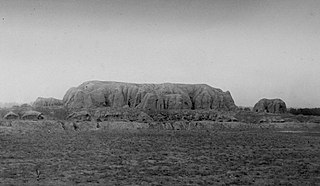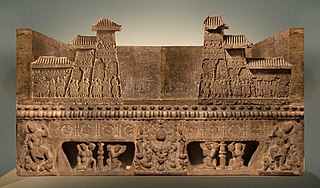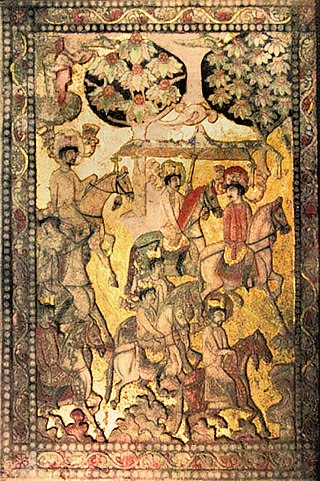
Sogdia or Sogdiana was an ancient Iranian civilization between the Amu Darya and the Syr Darya, and in present-day Uzbekistan, Turkmenistan, Tajikistan, Kazakhstan, and Kyrgyzstan. Sogdiana was also a province of the Achaemenid Empire, and listed on the Behistun Inscription of Darius the Great. Sogdiana was first conquered by Cyrus the Great, the founder of the Achaemenid Empire, and then was annexed by the Macedonian ruler Alexander the Great in 328 BC. It would continue to change hands under the Seleucid Empire, the Greco-Bactrian Kingdom, the Kushan Empire, the Sasanian Empire, the Hephthalite Empire, the Western Turkic Khaganate and the Muslim conquest of Transoxiana.
The Hephthalites, sometimes called the White Huns, were a people who lived in Central Asia during the 5th to 8th centuries CE, part of the larger group of Eastern Iranian Huns. They formed an empire, the Imperial Hephthalites, and were militarily important from 450 CE, when they defeated the Kidarites, to 560 CE, when combined forces from the First Turkic Khaganate and the Sasanian Empire defeated them. After 560 CE, they established "principalities" in the area of Tokharistan, under the suzerainty of the Western Turks and of the Sasanian Empire, before the Tokhara Yabghus took over in 625.

Zhou, known in historiography as the Northern Zhou, was a Xianbei-led dynasty of China that lasted from 557 to 581. One of the Northern dynasties of China's Northern and Southern dynasties period, it succeeded the Western Wei dynasty and was eventually overthrown by the Sui dynasty.
The Western Turkic Khaganate or Onoq Khaganate was a Turkic khaganate in Eurasia, formed as a result of the wars in the beginning of the 7th century after the split of the First Turkic Khaganate, into a western and an eastern Khaganate.

Sabao, or sārtpāw in Sogdian, was an official Chinese title in the 5th-7th centuries CE, used for government-appointed leaders of the Sogdian immigrant-merchant community. The word sabao is derived from the Sogdian word sārtpāw, "caravan leader". Sabaos also often had titles of "Prefects", with regional responsibilities, in the Chinese administration : An Jia was Sabao and Grand Governor of Tong Prefecture.

The Chinvat Bridge or the Bridge of the Requiter in Zoroastrianism is the sifting bridge, which separates the world of the living from the world of the dead. All souls must cross the bridge upon death. The bridge is guarded by two four-eyed dogs, described in the Videvdat (Vendidad) 13,9 as 'spâna pəšu.pâna'.
The First Turkic Khaganate, also referred to as the First Turkic Empire, the Turkic Khaganate or the Göktürk Khaganate, was a Turkic khaganate established by the Ashina clan of the Göktürks in medieval Inner Asia under the leadership of Bumin Qaghan and his brother Istämi. The First Turkic Khaganate succeeded the Rouran Khaganate as the hegemonic power of the Mongolian Plateau and rapidly expanded their territories in Central Asia. The khaganate became the first Central Asian transcontinental empire from Manchuria to the Black Sea.

The Afrasiab murals, also called the Paintings of the Ambassadors, is a rare example of Sogdian art. It was discovered in 1965 when the local authorities decided to construct a road in the middle of Afrāsiāb mound, the old site of pre-Mongol Samarkand. It is now preserved in a special museum on the Afrāsiāb mound.

Central Asian art is visual art created in Central Asia, in areas corresponding to modern Kyrgyzstan, Kazakhstan, Uzbekistan, Turkmenistan, Tajikistan, Afghanistan, and parts of modern Mongolia, China and Russia. The art of ancient and medieval Central Asia reflects the rich history of this vast area, home to a huge variety of peoples, religions and ways of life. The artistic remains of the region show a remarkable combinations of influences that exemplify the multicultural nature of Central Asian society. The Silk Road transmission of art, Scythian art, Greco-Buddhist art, Serindian art and more recently Persianate culture, are all part of this complicated history.

The Tomb of Yu Hong (Chinese: 虞弘墓; pinyin: Yú Hóng Mù; Wade–Giles: Yü2-Hung2-Mu4) is the grave of Yu Hong and his wife, dating back to 592 AD (Sui dynasty). The tomb was discovered by some locals in 1999 in Wangguo village in Jinyuan district of the city of Taiyuan, it was subsequently excavated officially in July of the same year. This tomb is so far the only archaeological find in the Central Plains region that reflects Central Asian (Western Regions) culture.

The Tomb of Wirkak (Sogdian: wyrkʾk), in Chinese commonly referred to as Tomb of Master Shi (Chinese: 史君墓; pinyin: Shǐ Jūn Mù; Wade–Giles: Shih3-Chün1 Mu4), is the grave of the Sogdian sārtpāw Wirkak and his wife Wiyusi, dating from 580 AD (Northern Zhou dynasty). The tomb was discovered in 2003 in the east of Jingshang village in Daminggong township, Weiyang District, Xi'an, and excavated between June and October in the same year. It is especially significant for the rich content of the reliefs on the stone structure contained in the tomb and a bilingual epitaph. Sogdian tombs in China are among the most lavish of the period in this country, and are only slightly inferior to Imperial tombs, suggesting that the Sogdian Sabao were among the wealthiest members of the population.

Kafir-kala is an ancient fortress 12 kilometers south of the city center of Samarkand in Uzbekistan, protecting the southern border of the Samarkand oasis. It consists in a central citadel built in mud-bricks and measuring 75 × 75 meters at its base has six towers and is surrounded by a moat, still visible today. Living quarters were located outside the citadel.

The murals of Penjikent are among the most famous murals of the pre-Islamic period in Panjakent, ancient Sogdiana, in Tajikistan. Numerous murals were recovered from the site, and many of them are now on display in the Hermitage Museum in Saint Petersburg, and in the National Museum of Antiquities of Tajikistan in Dushanbe. The murals reveal the cosmopolitan nature of the Penjikent society that was mainly composed of Sogdian and Turkic elites and likely other foreign merchant groups of heterogeneous origin. Significant similarities with Old Turkic clothing, weapon items, hairstyles and ritual cups are noted by comparative research.

The Ikhshids of Sogdia, or Ikhshids of Samarkand, were a series of rulers of Soghdia in Transoxiana, with their capital at Samarkand, during the pre-Islamic and early Islamic periods.

The Tomb of Ān Jiā, also sometimes read Ān Qié, is a Northern Zhou period funeral monument to a Sogdian nobleman named "An Jia" in the Chinese epitaph. The tomb was excavated in the city of Xi'an. It is now located in the collections of the Shaanxi Provincial Institute of Archaeology. An Jia (安伽) died in the founding year of the Daxiang (大象) era, during the reign of Emperor Jing.

The Anyang funerary bed, also known locally as the Bed of Ts'ao Ts'ao, is a Chinese funerary couch belonging to a Sogdian merchant and official active in China in the 6th century CE. The tomb was discovered in 1911, and the components of the funerary bed were dispersed among various museums in the world after being offered on the art market. It is thought the funerary bed was excavated in Anyang, capital of the Northern Qi dynasty. It is stylically dated to the Northern Qi dynasty.

The Tomb of Kang Ye is a Northern Zhou period funeral monument to a Sogdian nobleman and official in northern China named Kang Ye in his epitaph. The tomb was discovered in the northern suburbs of Xi'an in 2004. It is now located in the collections of the Xi'an City Museum. It is dated to 571 CE, from the epitaph.

The Tomb of Ān Bèi, is a 589 CE funeral monument of a Sogdian man named "An Bei" in his Chinese epitaph. The tomb was looted in 2006-2007, and its content sold in the art market. Part of the base of the tomb as well as the epitaph are now in the Tang West Market Museum (大唐西市博物館) in Xi'an.

The Tianshui tomb, also Tomb of Shimaping (Chinese:石马坪粟特墓) is a Sui dynasty funerary monument of an anonymous Sogdian nobleman and official in northern China. The tomb was discovered in the northern city of Tianshui in 1982. It is now located in the collections of the Tianshui City Museum (天水市博物馆). It is one of the major known examples of Sogdian tombs in China.

The Kooros couch is a 6-7th century funeral monument to an anonymous Sogdian nobleman and official in northern China. The tomb was probably discovered in the northern city of Tianshui in a clandestine excavation. It belonged to the "Vahid Kooros collection" after which it was named, and was briefly presented in the Musée Guimet in 2004, but has since disappeared. It is one of the major known examples of Sogdian tombs in China.





















